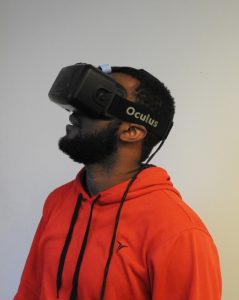If you are looking for a cheaper and more affordable desktop PC-powered VR headset, then the Oculus Rift is what you need. This headset isn’t one of those super high-tech VR glasses or one of those enclosed VR glasses that you expect to be the future of entertainment thanks to its low price. However, the future looks bright for this piece, and it may earn that “future of entertainment” title soon.
Pros and Cons of the Oculus Rift
Pros
- Offers quality VR games
- Perfect fit for any user
- Has a steadily increasing list of apps and movies
Cons
- Minimum PC requirements
- Can make user nauseous
- Some might consider it a significant investment
Specifications and Design
Even after being quite well over three years, the Oculus Rift isn’t that VR device that promised to change the world of entertainment when it launched in 2016. While it hasn’t become that device yet, its VR landscape has slowly improved over the years to become attractive. Now VR is taking over conferencing and other areas of work.
The Oculus Rift has gotten lots of opportunities to prove itself with different high-profile games launching on the hardware. They even upgraded the device to give it motion controllers in the form of the Oculus Touch. One other upgrade improvement is it requires the use of Windows 10 to launch all upcoming apps and features. However, it still supports Windows 7 and 8.1. So, if you use these Windows versions, you can continue playing games but be ready for an OS upgrade when new games are released.
Microsoft has even stopped providing mainstream support for Windows 7 and 8.1. now, they only give access to windows 10 users on performance standards due to a number of its users already operating on the Windows 10 OS.
The Oculus Rift, if you’ve been following it, requires a wired connection to function correctly and power two 1080 x 1200 resolution images to each of its lenses in the headset. Any PC cannot power it, it has to be a high-end gaming PC to enjoy the full functionality of the Rift. If you don’t like that better buy Oculus Go which is completely independent. If you want to try another setup you can sell broken or good vr head set to us and get the one you like.
Initially, the minimum specs that come with the Oculus are Intel Core i5 4950, AMD Radeon 290 or NVIDIA GTX 970 video card, and 8GB of RAM, but all that has changed. Now, they have reduced it to Intel core i3 6100 with NVIDIA GTX 960. This downgrade has reduced its price to $499 and below. It also now partners with a host of PC manufacturers to promote rift-ready computers.
If you pair this Rift with up to date hardware components, it will outperform most of its competitors like Google Cardboard, PlayStation VR, and Samsung Gear VR. Unlike the Oculus Rift, they all rely on the power of your smartphone to function.
Performance
The Oculus Rift is owned and operated by Facebook Inc, which ships out its first commercially available unit these days. This headset’s latest iteration is better than any of its previous versions and has an easy setup thanks to an in-built program that requires you to download it on its launch. Its installation and troubleshooting now take less technical know-how, so you can easily handle things when they go down south.
Like other VR headsets, The Oculus Rift completely immerses a user in a video game by producing two images simultaneously by connecting to the back of the user’s graphics card HDMI port and tracking your head movement through a camera. You can sit or stand while using the headset, and the Rift can track your movements in a small room now.
Final Verdict
The Oculus Rift is a smart piece of equipment. Even though it’s not the best out there, it has remained through to its vision. This is consumer-ready hardware, but it’s more than just a headset. This is a standard gaming device with a whole ecosystem of its own.


